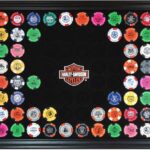I. Understanding Upcycling: What It Is and Why It’s Beneficial
II. Creative Ideas for Upcycling a Table
III. Step-by-Step Guide to Upcycling Your Table
Understanding Upcycling: What It Is and Why It’s Beneficial
Have you ever looked at an item in your home and thought, “I could do something amazing with that”? If so, you’re already on the path to understanding upcycling! This creative practice isn’t just a trendy buzzword; it’s a sustainable way to repurpose items that might otherwise end up in the landfill.
What Exactly Is Upcycling?
At its core, upcycling is about taking something old and giving it a new lease on life—often in a way that enhances its value or function. Unlike recycling, which usually breaks materials down into raw forms, upcycling focuses on transforming items without significant alteration to the original product.
Why Is Upcycling Beneficial?
- Environmental Impact: Upcycling helps reduce waste. By reimagining items rather than discarding them, we keep them out of landfills and decrease the demand for new products.
- Creativity Unleashed: Upcycling encourages you to think outside the box! It’s a fantastic way to express your creativity. You can personalize your space with unique items that reflect your style.
- Cost-Effective: Why spend a fortune on new furniture or décor when you can invest a little time and creativity into upcycling? It can be a wallet-friendly way to refresh your home.
- Story Behind Your Decor: Each upcycled item carries a story—whether it’s the piece’s history or the journey you took to transform it. This adds character and charm to your home, making it feel more personal.
- Skill Development: Upcycling often involves hands-on projects that can help you learn new skills, from DIY techniques to crafting. You might discover a hidden talent for woodworking, painting, or sewing!
Getting Started with Upcycling
If you’re intrigued by the idea of upcycling, you might be wondering where to begin. The beauty of upcycling is that it can be as simple or as complex as you want it to be. Start by looking around your home—what items do you have that could use a little transformation? Old furniture, glass jars, or even worn-out clothes can all be great candidates.
Once you spot something you’d like to upcycle, think about its potential. Could that rickety old chair become a vibrant plant stand? Can you turn an old dresser into a chic bathroom vanity? The possibilities are endless!
In a world that often feels overwhelming, upcycling serves as a reminder that we have the power to change our surroundings. It’s not just about reducing waste; it’s a celebration of creativity, sustainability, and personal expression. So why not grab that old table, unleash your imagination, and join the upcycling movement? You’ll be amazed at what you can create!
Creative Ideas for Upcycling a Table
Upcycling is all about transforming the old into something fabulous, and what better piece to start with than a table? Whether you have a tired old dining table, a simple side table, or even a coffee table that needs some love, there are countless ways to breathe new life into these pieces. Let’s dive into some creative ideas that can spark your imagination!
1. A Splash of Color
If your table has seen better days, a fresh coat of paint can work wonders. Here are some ideas:
- Bold and Bright: Choose a vibrant color that adds personality to your space. Think sunny yellows or deep blues!
- Ombre Effect: This trendy technique creates a beautiful gradient. Start with a light shade and gradually transition to a darker one.
- Chalk Paint: For a rustic vibe, use chalk paint. It’s easy to work with and gives a lovely matte finish.
2. Decoupage Delight
Decoupage is a fun way to personalize your table. You can use:
- Old Maps: For a travel enthusiast, cover the surface with maps that tell a story.
- Fabric: Use colorful fabrics for a soft, textured look. Just make sure to seal it with a protective top coat!
- Magazines or Scrapbook Paper: Get creative with clippings that represent your interests or favorite themes.
3. Adding Texture with Wood Stain
If you love the natural look, consider refinishing your table with wood stain. This works especially well for wooden tables:
- Light Sanding: Start by lightly sanding the surface to remove old finishes.
- Select Your Stain: Choose a stain that enhances the wood grain, such as walnut or mahogany.
- Sealing: After staining, seal it with a clear coat to protect your work and add a glossy finish.
4. Create a Mosaic Top
For the artistically inclined, a mosaic table can be a stunning centerpiece. Gather broken tiles, glass pieces, or even pebbles:
- Design Your Pattern: Before gluing anything down, lay out your design to see how it looks.
- Adhere Pieces: Use strong adhesive to attach your mosaic pieces to the table surface.
- Grout It: Once everything is set, fill the gaps with grout for a professional finish.
5. Use a Tablecloth or Runner
Sometimes, simplicity is best. A beautiful tablecloth or a stylish runner can change the whole vibe of your table:
- Seasonal Themes: Change tablecloths with the seasons for a fresh look year-round.
- Layering: Layer a solid color with a patterned runner for a chic, modern twist.
As you can see, the possibilities for upcycling a table are limitless! Whether you’re a DIY novice or a seasoned pro, these creative ideas can help you transform an old table into something uniquely yours. So grab your tools, unleash your creativity, and start your upcycling journey today!
Step-by-Step Guide to Upcycling Your Table
Ready to give that old table a fabulous makeover? Upcycling is not just a fun project; it’s a wonderful way to breathe new life into furniture that might otherwise end up in a landfill. Let’s dive into this step-by-step guide to upcycling your table, transforming it from drab to fab!
Step 1: Gather Your Supplies
Before you jump in, make sure you have everything you need. Here’s a handy list of supplies:
- Sandpaper or a power sander
- Primer and paint (or stain)
- Paintbrushes and rollers
- Sealant (if you’re using paint)
- Fabric or wallpaper (if you’re covering the surface)
- Glue (for fabric or wallpaper)
- Drop cloth or newspaper (to protect your work area)
Step 2: Prep Your Workspace
Find a well-ventilated area to work in, preferably outdoors or in a garage. Lay down your drop cloth to protect your floors. You might want to wear gloves to keep your hands clean and a mask to protect your lungs, especially when sanding.
Step 3: Clean the Table
Give your table a good clean to remove any dust, grime, or old finishes. A mix of soap and water will do the trick. Once it’s clean, let it dry completely.
Step 4: Sand the Surface
This step is crucial for a smooth finish! Use your sandpaper or power sander to remove any old paint, varnish, or rough spots. Focus on the top and any edges. Once you’re done, wipe off the dust with a damp cloth so your paint can adhere properly.
Step 5: Prime the Table
Applying a primer is important, especially if you’re using a light color or painting over a dark finish. It helps the paint to stick and enhances durability. Use a brush or roller to apply an even coat and let it dry completely.
Step 6: Paint or Stain
Now comes the fun part—adding color! Choose a paint that complements your home decor or go bold for a statement piece. Use a brush for corners and a roller for larger surfaces. If you’re staining, apply it with a rag, wiping off any excess. Remember to let it dry thoroughly between coats, usually at least 2-4 hours.
Step 7: Add a Top Coat
To protect your beautifully painted or stained table, apply a sealant. This step helps to ensure your work lasts through spills and daily use. Choose a matte or glossy finish depending on your style preference, and apply it according to the manufacturer’s instructions.
Step 8: Personalize Your Table
Want to take your upcycled table to the next level? Consider adding unique touches like:
- Decoupage with fabric or wallpaper
- Stenciled designs or quotes
- New hardware on drawers
- Adding decorative legs or feet
Step 9: Enjoy Your Upcycled Beauty!
Once everything is dry and set, place your table in its new home and admire your handiwork. Not only have you created something beautiful, but you’ve also contributed to a more sustainable world. Now, you have a functional piece of art that tells a story!
So, roll up your sleeves and get started on this exciting upcycling journey! Happy crafting!










Comments